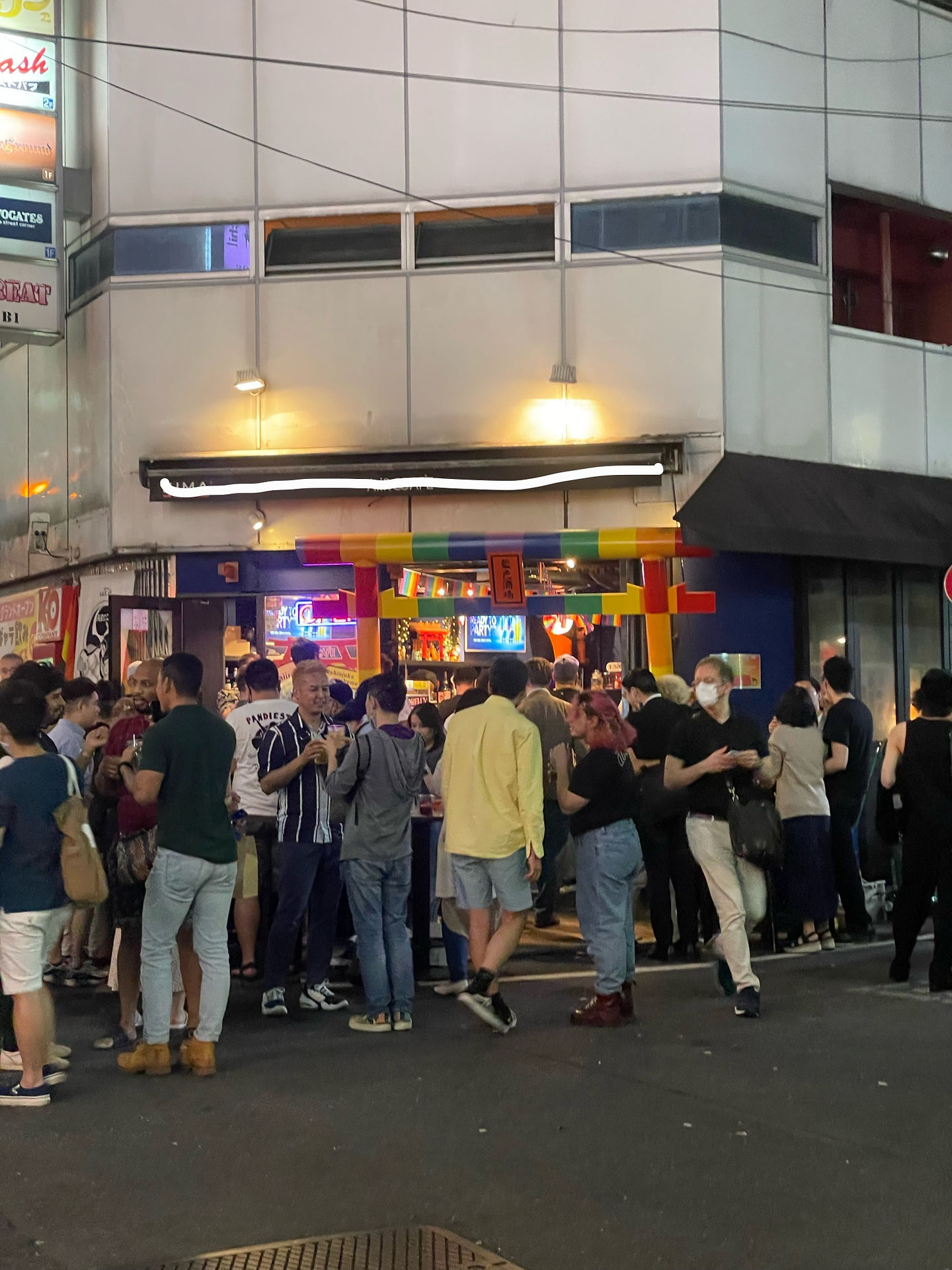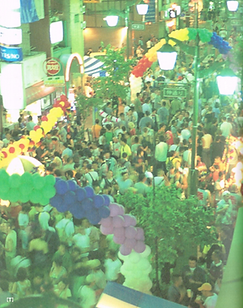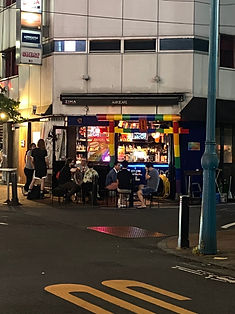
Introduction
Shinjuku Ni-chome's history
by Momo
Shinjuku Nichome’s history can go back as far as Edo Period when a post town (Syukuba)–soon to be known as Naito Shinjuku–was developed for travelers across the nation to rest and dine. Naito Shinjuku covers today’s Shinjuku San-chome to Yotsuya San-chome; Ni-chome was located at the center of the Syukuba, known for its concentration of brothels and prostitution–遊郭 (Yūkaku)–which at that time were both recognized by the Japanese government. The liveliness of the area was long impacted by the inconsistent legal framework for prostitution and in 1957 the 売春禁止法 (Prostitution Prevention Law) was enacted, leading much of Yūkaku to close its door. Following this event, a number of gay bars opened in Ni-chome to fill the void and have successfully branded itself as a gay town. As a prominent gay district, Ni-chome has earned political significance by hosting the Tokyo Rainbow Festival every year since 2000.
.png)
Portrayals of shinjuku ni-chome
by Yusuke
Shinjuku Ni-Chome is often portrayed as the “Gay District” of Japan (The Independent, 2010). This is because of the number of gay bars that are open inside the district but also due to the fact that Ni-chome is a place where various LGBTQ+-related events take place. The image on the left shows the first few news articles that pop up when one searches “Shinjuku Ni-chome” on Google. Most articles are about the views on the LGBTQ+ community or more recently, about the Monkeypox virus that has stigmatised the LGBTQ+ community, as the virus was associated with the growing number of cases amongst male homosexuals and bisexuals.

Decline of Shinjuku ni-chome
by Moe
Looking at the graph on the right, Shinjuku Ni-Chome falls under the “commodified/de-politicized space” through the de-gaying and gaytification process. This is because the district has had to largely commodify its space to counter its ongoing decline, stemming from digitalization (McNeill, 2010), gentrification (or gaytification) with the completion of the Fukutoshin Line (Deck, 2017), as well as the COVID-19 pandemic that has substantially decreased revenue in Ni-Chome (Lies, 2020).
Consequently, the LGBTQ town has arguably de-gayed itself to adopt a broader clientele—where “both heteronormativity and homonormativity” co-exist—at the cost of losing a closed and exclusive gay community. Moreover, it should be highlighted that Shinjuku Ni-Chome being a de-politicized space is rooted in the fact in stark contrast to gay neighborhoods in the United States, where sexual minorities continue to fight for their rights and personal safety, Ni-Chome is regarded “only as a temporary refuge, a place for amusement and leisure, by gay men and lesbians” (Susaki, 2021, Abstract).

Source: Queer Space: Exclusive or Inclusive
(Lashkari, 2018)
Activities in shinjuku ni-chome
by Karen


Ni-Chome, widely known for being a place for the LGBTQ community, serves as a place of social interactions, shopping, drinking, and many other activities, as will be illustrated in the following sub pages. To understand it better, we can use the terms of insiders and outsiders. For the insiders, it is a place where one can, and in some cases must, express their sexualities. Outside of Ni-chome, people must act out a certain social role as a heterosexual man or woman. In Ni-chome, you can identify with whatever you feel like (Susaki, 2021). However, since Ni-chome is a place of open sexualities, with the increase in outsiders, that can indicate a sort of risk for the insiders as strangers can expose you, leading to emotional or physical damage (Susaki, 2021). With this idea, exploring Ni-chome now you will find the dilemma of the people and city to be a place of inclusion as well as exclusion. In the business aspect, outsiders are needed to survive economically so businesses welcome outsiders. In contrast, the insiders no longer feel a sense of community and are timid towards outsiders, thus leading to the heterosexual exclusion by insiders. As explore Ni-chome now you will find the dilemma of the people and city to be a place of inclusion as well as exclusion. In the business aspect, outsiders are needed to survive economically so businesses are welcoming outsiders. In contrast, the insiders no longer feel a sense of community and are timid towards outsiders, thus leading to the heterosexual exclusion by insiders.
As we presented above, Shinjuku Ni-Chome faces a variety of issues due to the shrinking of gay communities and the influx of straight outsiders.
This webpage explores the current situation of Ni-chome through the following five subtopics: built environment, sexualities, heterosexual inclusion, services, and signboards.
The first section touches upon the shrinking of gay communities and the potential revitalization of Ni-chome through the use of the built environment and urban spaces.
The section on sexuality addresses the issues that arose from heterosexual inclusion by presenting gay insiders’ maneuvering of the risk.
The third section–heterosexual inclusion and exclusion–offers an alternative conceptualization of heterosexual patrons in gay space, aiming to propose the appropriate practice of exclusion/inclusion to achieve a harmonious environment in Ni-chome.
our themes and its importance
by Momo & Yusuke
The social interaction of service providers who are significant actors in creating a space of community building within commercial spaces like bars and clubs will be further examined in the fourth section.
Ni-chome is also a branded community, branding itself as an open and supportive community for LGBTQ+ people. Furthermore, some signboards suggest how it may be branding itself as a center of resistance against the conservative country.
Methodology
by Momo
This webpage was developed from research findings from two-month-long fieldwork in Shinjuku Ni-chome that lasted from June 2022 to July 2022. As we focus on commercial spaces–six bars/club sites as shown on the table to the right–the research was mostly conducted at night between the times of 19:30 to 22:00. Ethnographic research includes direct visual and auditory observations of buildings, patrons, bartenders, and signboards as well as several interviews with bartenders and patrons. In analyzing the research findings, scholarly literature is used to provide theoretical frameworks. Furthermore, comparable ethnographic works in/outside Japan are incorporated in the study to supplement our findings. To protect anonymity, all the bars and clubs examined are introduced with pseudonyms.
fieldsite
.png)
.png)


